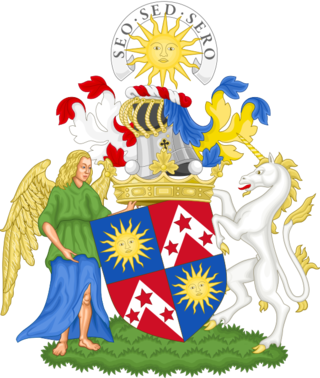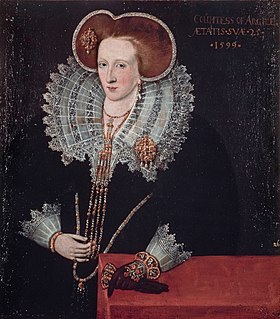Related Research Articles

Marquess of Lothian is a title in the Peerage of Scotland, which was created in 1701 for Robert Kerr, 4th Earl of Lothian. The Marquess of Lothian holds the subsidiary titles of Earl of Lothian, Earl of Lothian, Earl of Ancram (1633), Earl of Ancram, Viscount of Briene (1701), Lord Newbattle (1591), Lord Jedburgh (1622), Lord Kerr of Newbattle (1631), Lord Kerr of Nisbet, Langnewtoun, and Dolphinstoun (1633), Lord Kerr of Newbattle, Oxnam, Jedburgh, Dolphinstoun and Nisbet (1701), and Baron Ker, of Kersheugh in the County of Roxburgh (1821), all but the last in the Peerage of Scotland. As The Lord Ker in the Peerage of the United Kingdom, previous marquesses sat in the House of Lords before 1963, when Scottish peers first sat in the House of Lords in their own right. The holder of the marquessate is also the Chief of Clan Kerr.

General William Henry Kerr, 4th Marquess of Lothian was a Scottish nobleman, British soldier and politician, the eldest son of William Kerr, 3rd Marquess of Lothian. He was styled Master of Jedburgh until 1722, Lord Jedburgh from 1722 to 1735, and Earl of Ancram from 1735 to 1767. As the Earl of Ancram, he distinguished himself during the War of the Austrian Succession.
Mark Kerr, 1st Earl of Lothian was a Scottish nobleman and politician. He became the first Earl of Lothian in 1606.

William Kerr, first Earl of Lothian of a new creation (1605–1675) was a Scottish nobleman.

Robert Kerr, 1st Marquess of Lothian, known as the 4th Earl of Lothian from 1675 to 1701, was a Scottish nobleman. He was styled Lord Kerr until 1661 and Lord Newbattle from 1661 to 1675.

Robert Kerr, 1st Earl of Ancram, was a Scottish nobleman, politician and writer.
Robert Ker, 1st Earl of Roxburghe was a Scottish nobleman.
Anne Stanley, Countess of Ancram was an English aristocrat.
Jean Ker, Countess of Roxburghe, néeDrummond (c.1585–1643) was a Scottish courtier, serving Anne of Denmark in Scotland and England.

Agnes Leslie, Countess of Morton was a Scottish noblewoman, being the daughter of George Leslie, 4th Earl of Rothes as well as a great-granddaughter of King James II. She was the wife of William Douglas, 6th Earl of Morton, who as Laird of Lochleven Castle was the custodian of Mary, Queen of Scots during her captivity from June 1567 until her escape on 2 May 1568. Agnes was Queen Mary's chief female companion throughout her imprisonment; thus it was while Lady Agnes was recovering from childbirth that the queen successfully escaped from Lochleven.

Agnes Douglas, Countess of Argyll was a Scottish noblewoman and the first wife of Archibald Campbell, 7th Earl of Argyll. She was the mother of three of his children, including his heir, Archibald Campbell, 1st Marquess of Argyll, the de facto head of the government in Scotland throughout most of the conflict known as the Wars of the Three Kingdoms. Lady Agnes was considered so beautiful that she was described as a "pearl of Lochleven".

Christian(a) Cavendish, Countess of Devonshire (1595-1675) was an influential Anglo-Scottish landowner and royalist.
Robert Kerr, 2nd Earl of Lothian was a Scottish noble.

Marie Stewart, Countess of Mar (1576-1644) was a Scottish courtier. She was the daughter of Esmé Stewart, 1st Duke of Lennox, a favourite of James VI of Scotland, and Catherine de Balsac. After her marriage, as was customary in Scotland, she did not change her name, and signed her letters as "Marie Stuart".
John Murray, 1st Earl of Annandale was a Scottish courtier and Member of Parliament.

George Douglas of Parkhead,, was a Scottish landowner, mining entrepreneur, Provost of Edinburgh, and Keeper of Edinburgh Castle.
Margaret Stewart, Mistress of Ochiltree was a courtier in the household of Anne of Denmark in Scotland and looked after her children Prince Henry, Princess Elizabeth, and Charles I of England

Helen Leslie, Lady Newbattle (1520-1594) was a Scottish aristocrat and supporter of Mary, Queen of Scots.
Anne Kerr, Countess of Lothian was a Scottish aristocrat and landowner.
Sir John Seton was a Scottish aristocrat and soldier who wrote letters to his cousin Alexander Montgomerie, 6th Earl of Eglinton, previously known as Alexander Seton of Foulstruther.
References
- ↑ David Laing, Correspondence of Sir Robert Kerr, first Earl of Ancram, and his son William, third Earl of Lothian, vol. 1 (Roxburghe Club: Edinburgh, 1875), pp. lxvii, 149-50.
- ↑ David Laing, Correspondence of Sir Robert Kerr, first Earl of Ancram, and his son William, third Earl of Lothian, vol. 1 (Roxburghe Club: Edinburgh, 1875), p. c.